The story of three cartridges
- Transfer
Almost all video game lovers of a certain age are familiar with game cartridges and their principle of operation: you insert a cartridge into the console, turn it on and start the game. Less well-known cartridges that were not so simple, including a subset of devices designed to insert other cartridges into them . Let's look at three examples of such intermediate devices: we’ll find out why the creators of such cartridges even bothered by adding an extra cartridge slot, such as cartridges used games connected to them, and what advantages this unique design was given to the players themselves.
 Game Genie was probably one of the first video game cheating devices that a regular player faced on a home console. This tricky device was located between the Nintendo Entertainment System (NES) and standard game cartridges, and gave players the ability to adjust difficulty levels, move forward through the game, or simply experiment.
Game Genie was probably one of the first video game cheating devices that a regular player faced on a home console. This tricky device was located between the Nintendo Entertainment System (NES) and standard game cartridges, and gave players the ability to adjust difficulty levels, move forward through the game, or simply experiment.
For children in the 90s, Game Genie seemed like a real magic. First you inserted one of the game cartridges into Game Genie. Then, not without effort (because it was inserted rather hard), you connected the construction from Game Genie and the game to the console and turned it on. But instead of the usual launch of the game, a mysterious screen appeared asking to enter meaningless passwords 1 . Each password influenced the game in its own way, and in no game passwords were repeated.
So how did Game Genie fulfill the wishes of the players? Versions of Game Genie existed for NES, Super NES and Game Boy, as well as for Sega Genesis and Game Gear. They intercepted the exchange of data between the console and the game cartridge. The internal operation of the game console was controlled by bits and bytes, so the ability to overwrite the data transferred from the cartridge to the console allowed Game Genie to perform incredibly powerful tricks.
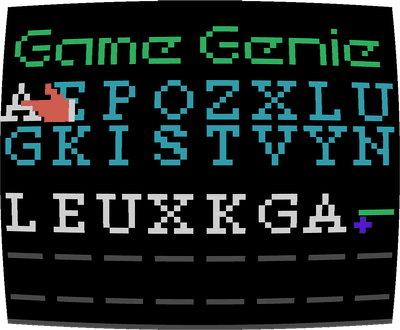
Game Genie password entry screen on NES.
In fact, the password entered told Game Genie what to do: replace one part of the game's program code, change the initial value of another data value in memory, or not allow the third part of the memory to change . For example, if you insert Super Mario Bros. into Game Genie . 3 , and then enter the password
The first version of Game Genie was developed in the late 1980s by the British company Codemasters. Although this was the first cheat cartridge for a video game console, it was not the first cheat cartridge in history. Cheat cartridges initially appeared on the home computer market, and their first example was the 1986 Action Replay 2 3 . Initially, Codemasters was a developer of games for Commodore computers, so it is likely that it drew inspiration from Action Replay.
One way or another, after several years of successful sales and a long legal battle with Nintendo, Game Genie cartridges disappeared when optical discs became the main medium of information in home consoles.
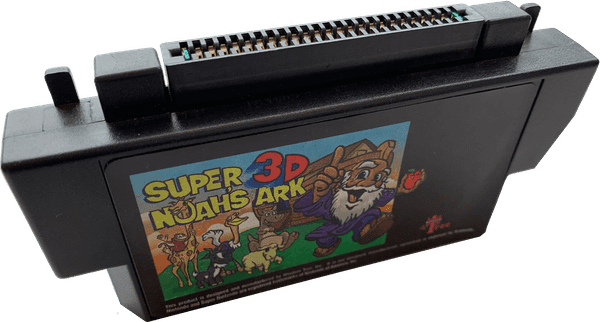
Super 3D Noah's Ark is ready to connect another cartridge.
The early 1990s were auspicious time for the gray market for Christian-themed video games. Most of the religious games of that era were base imitations of more popular games with chaotic inserts of Bible references. Therefore, very few of these games are of interest to us 4 . Super 3D Noah's Ark turned out to be rather strange, and therefore has won our attention.
First, the Super 3D Noah's Ark gameplay was, oddly enough, based on Wolfenstein 3 – D superhard first-person shooterid Software. Only instead of wandering through the dark corridors of the Nazi fortress, did the players run along the Noah’s ark, forcing rebellious animals to fall asleep with food.
The process of transition from Nazi to biblical themes was rather confusing. When Wolfenstein 3 – D was ported to Super NES after its initial release on PC , Nintendo demanded that id make significant changes to the game’s content. The original version of the game was too cruel for Nintendo, which saw its console as a product for young players, and hence their parents, who, in fact, purchased the console. The id company complied, but was not happy. So she made a charming diversion and sold a license for the Wisdom Tree 5 game engine- An unlicensed Nintendo developer who created mediocre religious video games. Wisdom Tree simply redrawn the content and named the game its own. Instead of controlling an American soldier hung with weapons, the players took on the role of Noah armed with a slingshot, pacifying the rebellious goats and sheep instead of the Nazis.
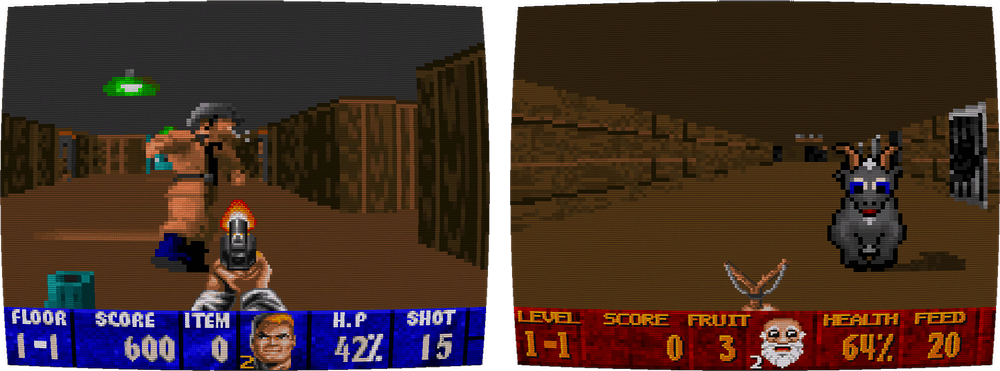
Left: Wolfenstein 3 – D. Right: Super 3D Noah's Ark.
Wonderfully gaining the rights to one of the most powerful engines of the time, Wisdom Tree should now find a way to publish Super 3D Noah's Ark.but it was not easy. In the 80s and 90s, Nintendo had a strict set of rules that games should follow (the same rules were infuriated by id Software), and one of the points was a complete ban on any religious content. Despite the ban, there was a small artisanal industry of religious video game developers who were desperate to capitalize on the craziness of video games. They sold games to virtuous parents who sought to instill their values in their children through this new form of entertainment. However, all these developers faced one technical problem: Nintendo consoles did not launch cartridges that did not have the proprietary Checking Integrated Circuit (CIC) security chips. Games outperforming the original NES CIC chips were fairly widespread 6 , butSuper 3D Noah's Ark was the only unlicensed game for Super NES.
A glance at the Noah's Ark Super 3D plug-in cartridge is enough to understand its entire story. Unhappy that the NES console's CIC chip could be easily sabotaged, Nintendo created a stronger version of the chip for Super NES. To circumvent the CIC chip, Super 3D Noah's Ark required the player to first connect a regular licensed Super NES cartridge to it from above and then insert Super 3D Noah's Ark into the console. The cunning scheme allowed CIC signals to be transmitted through an unlicensed cartridge into a licensed game, making the console believe that a licensed game was running.
This was a masterful solution to a creative problem, and despite the rather unusual appearance, the cartridge add-on did its job. It may seem surprising that such a strategy has not spread 7 , but Super NES has not attracted much attention to the religious games industry. At the same time, bible-themed illegal games for NES continued to be released even after the release of official games 8 stopped .
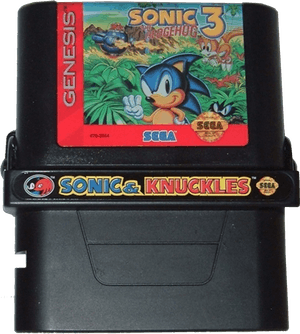
Sonic & Knuckles with Sonic the Hedgehog 3 connected to it.
The latter we will look at Sonic & Knuckles , a 1994 game for Sega Genesis that complements the original Sonic the Hedgehog series . Unlike the two previous cartridges we examined, Sonic & Knuckles is fully functional in itself and contains six levels of the classic platformer. At first, it does not even seem anything special - its cartridge looks a little strange, but it does not look like the first two. But instead of the top label, like on regular Genesis cartridges, it has a hinged lid under which there is a slot for another Genesis cartridge.
This cartridge has a few tricks in its sleeve. Depending on the game connected to it, you can see three results. When connecting most Genesis games, players could play variations of the bonus levels from Sonic the Hedgehog 3 with blue balls. Sonic & Knuckles read the identifier of the second cartridge and, depending on it, changed the scheme of bonus levels. Players could experiment with different games and find different sets of levels; for example, if you connect ToeJam & Earl , you will get a set of very difficult levels, if Altered Beast , then you are more lucky.
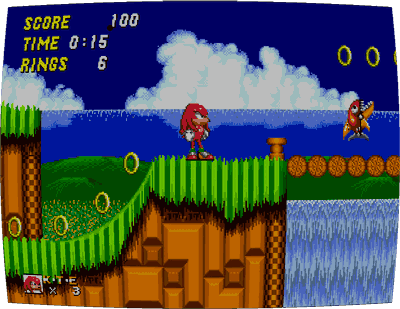 With Sonic the Hedgehog 2the situation was more interesting. Sonic & Knuckles read data from the Sonic 2 cartridge and replaced Sonic with the Knuckles character, without changing all of Sonic's abilities. This meant that players could play a new character in a game released several years before this character was invented.
With Sonic the Hedgehog 2the situation was more interesting. Sonic & Knuckles read data from the Sonic 2 cartridge and replaced Sonic with the Knuckles character, without changing all of Sonic's abilities. This meant that players could play a new character in a game released several years before this character was invented.
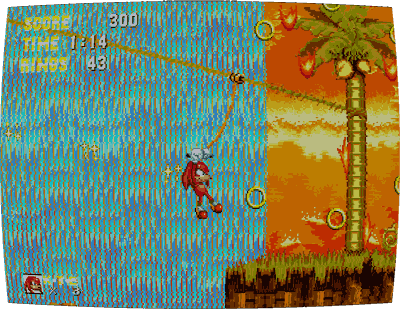 However, the real star of this show was Sonic the Hedgehog 3 . By connecting this game (released only eight months earlier than 9 , the player received Sonic 3 & Knuckles - a new gameplay that smoothly flows from Sonic the Hedgehog 3 levels to Sonic & Knuckles levels. This combination was considered a “real” version of the game, and its unusual release strategy was the result of tight time constraints - Sega released the first half of the game as soon as it was ready, and later that year released the second half as a plug-in cartridge 10 .
However, the real star of this show was Sonic the Hedgehog 3 . By connecting this game (released only eight months earlier than 9 , the player received Sonic 3 & Knuckles - a new gameplay that smoothly flows from Sonic the Hedgehog 3 levels to Sonic & Knuckles levels. This combination was considered a “real” version of the game, and its unusual release strategy was the result of tight time constraints - Sega released the first half of the game as soon as it was ready, and later that year released the second half as a plug-in cartridge 10 .
Despite the fact that players had to buy two cartridges to play the full version of Sonic the Hedgehog 3 , the connection trick seemed such a novelty that it was worth it. Unfortunately, Sonic & Knuckles was the only plug-in cartridge of its kind.
Video game cartridges were a very remarkable medium of information 11 , full of surprises and providing ample opportunities for creating inventive additions. These cartridges are just a small example from the complex and amazing history of bizarre hardware hacks and intermediate equipment that allowed them to overcome the limitations of consoles and provide players with unique gameplay. In the second part, we look at the older brothers of the plug-in cartridges: video game cartridges, which in themselves were separate video game systems.
Game genie
 Game Genie was probably one of the first video game cheating devices that a regular player faced on a home console. This tricky device was located between the Nintendo Entertainment System (NES) and standard game cartridges, and gave players the ability to adjust difficulty levels, move forward through the game, or simply experiment.
Game Genie was probably one of the first video game cheating devices that a regular player faced on a home console. This tricky device was located between the Nintendo Entertainment System (NES) and standard game cartridges, and gave players the ability to adjust difficulty levels, move forward through the game, or simply experiment. For children in the 90s, Game Genie seemed like a real magic. First you inserted one of the game cartridges into Game Genie. Then, not without effort (because it was inserted rather hard), you connected the construction from Game Genie and the game to the console and turned it on. But instead of the usual launch of the game, a mysterious screen appeared asking to enter meaningless passwords 1 . Each password influenced the game in its own way, and in no game passwords were repeated.
So how did Game Genie fulfill the wishes of the players? Versions of Game Genie existed for NES, Super NES and Game Boy, as well as for Sega Genesis and Game Gear. They intercepted the exchange of data between the console and the game cartridge. The internal operation of the game console was controlled by bits and bytes, so the ability to overwrite the data transferred from the cartridge to the console allowed Game Genie to perform incredibly powerful tricks.

Game Genie password entry screen on NES.
In fact, the password entered told Game Genie what to do: replace one part of the game's program code, change the initial value of another data value in memory, or not allow the third part of the memory to change . For example, if you insert Super Mario Bros. into Game Genie . 3 , and then enter the password
LEUXKGAA, then you will be taken to the world 1-1 and Mario will already turn into Raccoon-Mario.The first version of Game Genie was developed in the late 1980s by the British company Codemasters. Although this was the first cheat cartridge for a video game console, it was not the first cheat cartridge in history. Cheat cartridges initially appeared on the home computer market, and their first example was the 1986 Action Replay 2 3 . Initially, Codemasters was a developer of games for Commodore computers, so it is likely that it drew inspiration from Action Replay.
One way or another, after several years of successful sales and a long legal battle with Nintendo, Game Genie cartridges disappeared when optical discs became the main medium of information in home consoles.
Super 3D Noah's Ark

Super 3D Noah's Ark is ready to connect another cartridge.
The early 1990s were auspicious time for the gray market for Christian-themed video games. Most of the religious games of that era were base imitations of more popular games with chaotic inserts of Bible references. Therefore, very few of these games are of interest to us 4 . Super 3D Noah's Ark turned out to be rather strange, and therefore has won our attention.
First, the Super 3D Noah's Ark gameplay was, oddly enough, based on Wolfenstein 3 – D superhard first-person shooterid Software. Only instead of wandering through the dark corridors of the Nazi fortress, did the players run along the Noah’s ark, forcing rebellious animals to fall asleep with food.
The process of transition from Nazi to biblical themes was rather confusing. When Wolfenstein 3 – D was ported to Super NES after its initial release on PC , Nintendo demanded that id make significant changes to the game’s content. The original version of the game was too cruel for Nintendo, which saw its console as a product for young players, and hence their parents, who, in fact, purchased the console. The id company complied, but was not happy. So she made a charming diversion and sold a license for the Wisdom Tree 5 game engine- An unlicensed Nintendo developer who created mediocre religious video games. Wisdom Tree simply redrawn the content and named the game its own. Instead of controlling an American soldier hung with weapons, the players took on the role of Noah armed with a slingshot, pacifying the rebellious goats and sheep instead of the Nazis.

Left: Wolfenstein 3 – D. Right: Super 3D Noah's Ark.
Wonderfully gaining the rights to one of the most powerful engines of the time, Wisdom Tree should now find a way to publish Super 3D Noah's Ark.but it was not easy. In the 80s and 90s, Nintendo had a strict set of rules that games should follow (the same rules were infuriated by id Software), and one of the points was a complete ban on any religious content. Despite the ban, there was a small artisanal industry of religious video game developers who were desperate to capitalize on the craziness of video games. They sold games to virtuous parents who sought to instill their values in their children through this new form of entertainment. However, all these developers faced one technical problem: Nintendo consoles did not launch cartridges that did not have the proprietary Checking Integrated Circuit (CIC) security chips. Games outperforming the original NES CIC chips were fairly widespread 6 , butSuper 3D Noah's Ark was the only unlicensed game for Super NES.
A glance at the Noah's Ark Super 3D plug-in cartridge is enough to understand its entire story. Unhappy that the NES console's CIC chip could be easily sabotaged, Nintendo created a stronger version of the chip for Super NES. To circumvent the CIC chip, Super 3D Noah's Ark required the player to first connect a regular licensed Super NES cartridge to it from above and then insert Super 3D Noah's Ark into the console. The cunning scheme allowed CIC signals to be transmitted through an unlicensed cartridge into a licensed game, making the console believe that a licensed game was running.
This was a masterful solution to a creative problem, and despite the rather unusual appearance, the cartridge add-on did its job. It may seem surprising that such a strategy has not spread 7 , but Super NES has not attracted much attention to the religious games industry. At the same time, bible-themed illegal games for NES continued to be released even after the release of official games 8 stopped .
Sonic & knuckles

Sonic & Knuckles with Sonic the Hedgehog 3 connected to it.
The latter we will look at Sonic & Knuckles , a 1994 game for Sega Genesis that complements the original Sonic the Hedgehog series . Unlike the two previous cartridges we examined, Sonic & Knuckles is fully functional in itself and contains six levels of the classic platformer. At first, it does not even seem anything special - its cartridge looks a little strange, but it does not look like the first two. But instead of the top label, like on regular Genesis cartridges, it has a hinged lid under which there is a slot for another Genesis cartridge.
This cartridge has a few tricks in its sleeve. Depending on the game connected to it, you can see three results. When connecting most Genesis games, players could play variations of the bonus levels from Sonic the Hedgehog 3 with blue balls. Sonic & Knuckles read the identifier of the second cartridge and, depending on it, changed the scheme of bonus levels. Players could experiment with different games and find different sets of levels; for example, if you connect ToeJam & Earl , you will get a set of very difficult levels, if Altered Beast , then you are more lucky.
 With Sonic the Hedgehog 2the situation was more interesting. Sonic & Knuckles read data from the Sonic 2 cartridge and replaced Sonic with the Knuckles character, without changing all of Sonic's abilities. This meant that players could play a new character in a game released several years before this character was invented.
With Sonic the Hedgehog 2the situation was more interesting. Sonic & Knuckles read data from the Sonic 2 cartridge and replaced Sonic with the Knuckles character, without changing all of Sonic's abilities. This meant that players could play a new character in a game released several years before this character was invented.  However, the real star of this show was Sonic the Hedgehog 3 . By connecting this game (released only eight months earlier than 9 , the player received Sonic 3 & Knuckles - a new gameplay that smoothly flows from Sonic the Hedgehog 3 levels to Sonic & Knuckles levels. This combination was considered a “real” version of the game, and its unusual release strategy was the result of tight time constraints - Sega released the first half of the game as soon as it was ready, and later that year released the second half as a plug-in cartridge 10 .
However, the real star of this show was Sonic the Hedgehog 3 . By connecting this game (released only eight months earlier than 9 , the player received Sonic 3 & Knuckles - a new gameplay that smoothly flows from Sonic the Hedgehog 3 levels to Sonic & Knuckles levels. This combination was considered a “real” version of the game, and its unusual release strategy was the result of tight time constraints - Sega released the first half of the game as soon as it was ready, and later that year released the second half as a plug-in cartridge 10 . Despite the fact that players had to buy two cartridges to play the full version of Sonic the Hedgehog 3 , the connection trick seemed such a novelty that it was worth it. Unfortunately, Sonic & Knuckles was the only plug-in cartridge of its kind.
Conclusion
Video game cartridges were a very remarkable medium of information 11 , full of surprises and providing ample opportunities for creating inventive additions. These cartridges are just a small example from the complex and amazing history of bizarre hardware hacks and intermediate equipment that allowed them to overcome the limitations of consoles and provide players with unique gameplay. In the second part, we look at the older brothers of the plug-in cartridges: video game cartridges, which in themselves were separate video game systems.
Notes
- Hackaday has a short article on Game Genie that is worth reading. The main idea was that part of the passwords was identified as part of the game’s memory, and the rest of the code told Game Genie what to do with it: either always keep the same value of a certain value, or change it depending on the current state. This is both a simple and brilliant idea.
- The first specialized cheat device was Action Replay , released for Commodore 64 in 1986. Like Game Genie, it spawned a series of variations for different computers and consoles that were released over the next ten years.
- The predecessor of special cheat devices was such hardware peripherals as Multiface , which provided enthusiasts with unprecedented access to the insides of their computers. It allowed users to do almost everything with the software running on their computer, including the use of cheats.
- If you are not confused by obscene language and toilet jokes, then YouTube has the Angry Video Game Nerd channel, which provides a humorous overview of a fairly large number of such games .
- Some people find the story of the sale of id Software license by Wisdom Tree apocryphal. It is difficult to confirm one or another point of view, but this fact is included in the 2004 book of Masters of Doom (p. 121). Be that as it may, the Super 3D Noah's Ark is truly based on the Wolfenstein 3 – D version for Super NES.
- Tengen (owned by Atari) became the most famous publisher of unlicensed games for NES, but it did without Nintendo's approval by illegally reverse engineering the CIC chip for NES using documentation submitted by Nintendo to the U.S. Patent Office. Camerica turned out to be a more honest (and interesting) example : its strategy of bypassing the blocking chip was to transmit buggy electrical pulses that temporarily “cut” the chip.
- The unlicensed game Little Red Hood , which is considered by many to be one of the worst projects for NES, also used a similar scheme with a connecting cartridge.
- Sunday Funday was the last console game released in North America, at least until the surge in interest in vintage gaming in the 21st century.
- Sonic the Hedgehog 3 was released in North America on February 2, 1994, and only 258 days later (October 18), Sonic & Knuckles appeared .
- See the Sonic & Knuckles development section of the Wikipedia article for details .
- On my blog this topic is often addressed; see for example my previous article on the history of save games . It tells how permanent memory was added to video game cartridges thanks to a small “tablet” battery. There are countless other examples of the greatness of cartridges that I will ever consider.
